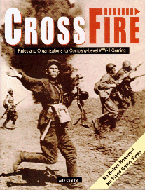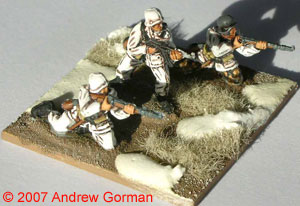 Crossfire is finally back in print and readily available – you can find it at these stockists:
Crossfire is finally back in print and readily available – you can find it at these stockists:
- On Military Matters (USA)
- Caliver Books (UK)
Rules and Organizations for Company-Level WW-II Gaming
 Crossfire is finally back in print and readily available – you can find it at these stockists:
Crossfire is finally back in print and readily available – you can find it at these stockists:
 We’ve had many enquiries from gamers wanting to source a copy of Crossfire and/or Hit The Dirt. Both these publications are now out of print, but limited numbers are still available from various retailers, along with many of Arty Conliffe’s other rules. The following is a list of where all of these are or may be available and the approximate availability (quantities) as at the date of the last update.
We’ve had many enquiries from gamers wanting to source a copy of Crossfire and/or Hit The Dirt. Both these publications are now out of print, but limited numbers are still available from various retailers, along with many of Arty Conliffe’s other rules. The following is a list of where all of these are or may be available and the approximate availability (quantities) as at the date of the last update.
This list was updated on 24 June 2011.

Andrew Gorman in New Zealand painted up these 1/72nd scale (20mm) figures from Revell with vehicle kits from Airfix & Fujimi.

It’s 1943 and the Germans are realising there’s no easy victories! Behind German lines large numbers of Soviet Partisans are operating and the Germans are expecting the worst. The terrain is the ‘usual’ crossfire mix, with three, ‘one sector’ villages, several hills and fields, and many woods.
The Russians place the hidden supply dumps before they know the direction of the German advance. Once the direction is determined, (either randomly, or secretly predetermined by the umpire), then the Russian uses hidden deployment, leaving about12’’ for the German player to deploy in. The German then places all his forces, and commences the game with the initiative.

In the centre of the board is a village. A road leads from one corner to the centre of the village. Either side of the road, at the table edge, is some good cover. As always, there’s lots of terrain/cover all around. The attacker’s objective is towards the edge of the village, thus reasonably near the centre of the board, but on the far side of the village from the road. For me, the objective was a V2 rocket on its launch pad. I also had a couple of large ponds, which were impassable areas which didn’t block line of sight, forcing troops and vehicles to circle around them, which worked quite well.

The board is rectangular. Across the centre width-ways, is a canal or straight section of river, dividing the table into two “square” halves. In the centre of the board is a bridge crossing the water.
This a sort of Market Garden or Pegasus Bridge type scenario.
The defender has regular troops. He has two or three companies of these, depending on the strength of his vehicles. He may deploy BOTH sides of the water, and half his forces may be hidden. He has some decent anti-tank guns, which may be deployed hidden. He also has a number of other vehicles (SPGs, armoured cars, prime movers etc.) which are on his home side of the river. Ideally, these vehicles should not be turreted tanks. On his home side of the river, are the defender’s mortars, on-table. FOs may all be hidden.

Joe Kelly provides details of the infantry (the non-Fallschirmjäger type) that proved the bulk of the manpower in the Luftwaffe Field Divisions. The “Jäger” Regiments were formed mostly from Ground Crew and rear area troops and a typical regiment as as follows:
Luftwaffe Field Regiment
Regimental Headquarters
3-4, later 2, Luftwaffe Field Battalions, with;
Headquarters
3 Light Companies
1 Heavy Company
Continue reading “German Luftwaffe Field Regiment 1942-1945”

Joe Kelly provides his take on the German Gebirgsjäger (Mountain Troops) organisation for the mid-war period. The TO&E had been reorganised from what was present early way, and in 1943 the Regiment was organised as follows:
Regimental HQ Group
1 Signal Platoon
1 Technical Company, with;
1 Signal Platoon
1 Engineer Platoon
1 Light Howitzer Platoon
1 Heavy Mountain Howitzer Battery

In the rules, Arty suggests that each base have a couple of numbers written on it; one number would denote company membership, the other platoon membership. He also suggests the use of prone figures, wounded figures and rubble to mark whether a unit is Pinned, “No Fire”, Suppressed or Ground Hugging. I like the latter because it does not involve a nasty number or word written on a card, which would spoil the look of my battlefield. I dislike the former for the same reasons.

You will need a large table and lots of terrain. The rules suggest covering a third of the table with terrain. I find that half is better and two thirds not too much. You need the large table to give room for manoeuvre.
You should put a few layers of terrain between starting positions and objectives, so that there is not too much open ground to cross. If you don’t do this, then the player starting with the initiative has it too easy advancing to objectives, while retaking objectives will be too hard, since it will be so easy to place defending troops in the right place to ward off an attack. You need lots of small pieces of terrain. Actually, I’d say that the amount of the table covered by terrain is less important than the number of terrain pieces, because big bits of terrain (you should have a few, though) are little more useful than small. The number of pieces of terrain between one place and another makes more difference than the amount of the table covered between one place and another. With lots of bits of terrain, defenders can not sweep large areas of open terrain with their fire, are more easily frustrated by smoke, and can less easily predict the direction of the attack.